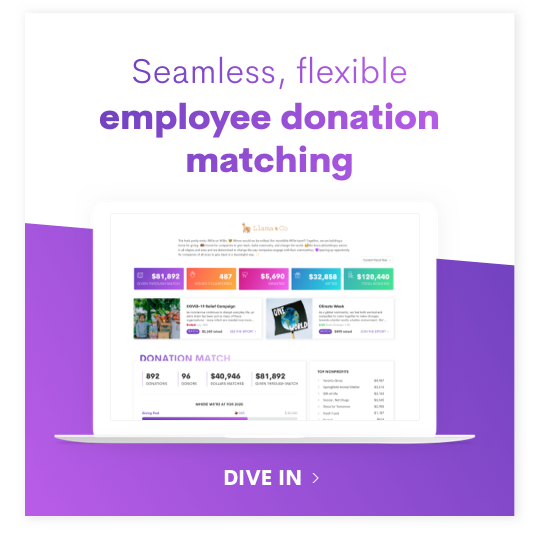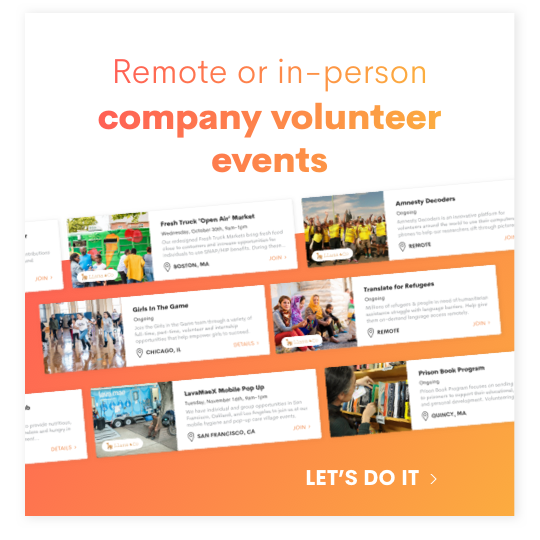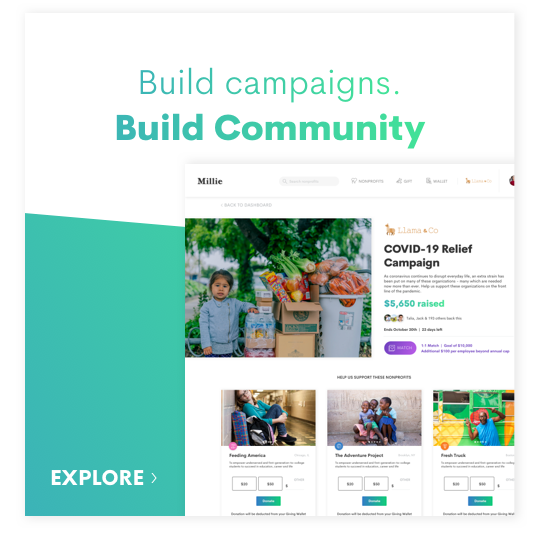If you’re looking to incorporate social impact into your business, participating in corporate giving is one of the best ways to do so. Not only do these programs benefit the businesses offering them, but they also provide substantial positive impacts to just about everyone involved.
Interested in learning how? We’ll share the basics of corporate giving programs, the reasoning behind corporations’ participation in the programs, and key benefits to each category of stakeholders in this guide.
Let’s get started!
What are Corporate Giving Programs?
Corporate giving programs are a form of corporate philanthropy that empower giving from businesses to nonprofit organizations. These initiatives may include:
- Matching employee donations to the nonprofits their employees support with their dollars
- Providing volunteer grants (also known as “dollars for doers”) to the nonprofits their employees volunteer their time with
- Establishing paid volunteer time off for employees to volunteer with nonprofit causes (above and beyond typical PTO hours)
- Facilitating employee volunteer opportunities during or outside of work hours
- Organizing internal fundraising campaigns on behalf of nonprofit causes
- Gifting charitable dollars to employees and consumers to contribute on behalf of nonprofit causes
- Offering corporate grants to nonprofit organizations
- Sponsoring nonprofit fundraising events by providing funding or media coverage
- Donating a portion of sales or proceeds to nonprofit causes
- Providing in-kind or non-monetary donations of products or services to nonprofit causes
Programs that specifically involve participation from a company’s employees are often referred to as workplace or employee giving programs, which are a subset of corporate giving programs.
The Impact of Corporate Giving Programs on Key Stakeholders
Corporate giving programs form strategic partnerships between companies and nonprofits, and there are a range of stakeholders who benefit from the relationship.
Let’s walk through each party and the impact that they see from the philanthropic programming;
Business Owners
Companies participate in corporate giving—such as matching gifts, volunteer grants, and more—for several reasons. These tend to include (but are not limited to):
- Employee engagement (and subsequently, increased productivity and decreased staff turnover) from working at a company that promotes social good
- Attracting new team members (research indicates that 71% of employees state it’s very important to work at a company that partakes in philanthropy, while 2/3 of young employees won’t take a job at a company with poor CSR practices)
- Optimal brand reputation (and increased sales) through unique cause marketing opportunities and overall elevated awareness
- Tax deductions from supporting registered 501(c)(3) causes (including a major exception to the 10% rule regarding matching gifts)
- Genuine altruism (and the feelings of good that come with it!)
For many companies, corporate giving programs like the ones listed above are viewed as strategic investments. Though it requires funding to get involved, the ROI that comes is typically many times over!
Employees
Now more than ever before, employees desire to work for companies that participate in social good. No longer is making a profit and paying a fair wage all that’s being demanded from corporations, and team members are making a point to dedicate their own talents to businesses whose values match their own.
These types of jobs tend to be both more engaging and more fulfilling—especially when the employing company makes an effort to give directly to the organizations their employees support themselves.
Nonprofits
As the direct recipient of corporate philanthropy funding, nonprofit organizations are perhaps the most evident beneficiaries of corporate giving programs. For example, when a company establishes grant funding, it’s typically nonprofit causes that are available to apply for and collect on the revenue. Businesses that match employee donations often do so to nonprofit organizations of all shapes and sizes, enabling teams to collect twice as many funds with little to no added effort on their part.
These partnerships ultimately empower charitable organizations to do more—to reach more constituents, to expand their mission programming, and to offer more and better services to their communities.
Customers
Like employees, corporate consumers are also becoming increasingly drawn to businesses that partake in philanthropic efforts. Customers know that the dollars they spend have a lot of power, and they’re wanting to spend them supporting companies that give back. And when consumers spend their money at businesses that offer corporate giving programs, they can feel good about their purchases making a difference.
Communities
When it comes to corporate philanthropy, communities are another key stakeholder in the programs—despite often being overlooked in the equation. Though community members may not be directly impacted by corporate giving funds offered to nonprofits around them, they can certainly benefit from improved programming or increased access to an organization’s services that are made available by additional sources of revenue.
Consider this: a nonprofit may be able to aid twice as many constituents thanks to matching gift funding—or whichever form of corporate giving they receive. Now, Sally and her family are able to receive much-needed resources from her local food pantry, whereas previously, the organization had struggled to keep their supplies stocked.
Corporate giving programs are often referred to as a win-win situation. But when you really look at it, calling these initiatives a win-win-win-win-win is likely to be a more accurate representation.
As a company, if you’re thinking about expanding your corporate philanthropy initiatives—whether rolling out a workplace giving program for the first time or looking to offer additional grant funding beyond your existing reserves—be sure to consider all the different groups that your offering can benefit, including your own. Best of luck, and happy giving!



